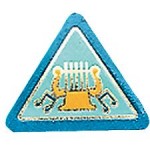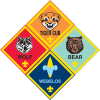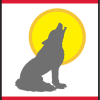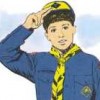Belt Loop
Complete these three requirements
- Explain why music is an important part of our culture.
- Learn a song with at least two verses and sing the verses with your den or to an adult family member.
- Listen to four different types of music either recorded or live.
Academics Pin
Earn the Music belt loop and complete five of the following requirements.
- Make a musical instrument and play it for your family, den, or pack.
- Teach your den a song.
- Play a song by yourself or in a group, in unison or in harmony.
- Create an original melody and/or original words for a song.
- Using a tape recorder, capture natural sounds of the environment or record songs you create, and use your recording as a soundtrack for a short skit or as background for a movement activity.
- Attend a live musical performance or concert.
- Demonstrate conducting patterns for two songs using two different meters (two-, three-, or fourbeat meter) while your adult partner or den members sing or play the songs you have selected.
- Take voice or dance lessons or lessons to learn to play an instrument.
- Create movements to a piece of music without words to demonstrate the moods of the music: happy, sad, calm, excited, playful, inspired.
- Learn about a composer of some music that you enjoy. Tell your den or an adult family member what you learned about him or her.
Additional Information
How a Child’s Singing Voice Develops
The Skill Ladder
1. Discovers his singing voice.
2. Approximates correct pitches.
3. Matches tones (pitches).
4. Learns to sing very short songs involving a small range.
5. Memorizes words of songs.
6. Increases ability to sing in tune.
7. Increases abilities in length, range, and musical difficulty.
8. Continues to improve tone quality.
9. Becomes an independent singer; can stay in tune as an accompaniment is played; can sing rounds, etc.
10. Sings expressively.
11. Enunciates well.
12. Learns to breathe in the appropriate places.
13. Sings two- and three-part harmony. Wherever your child has progressed in the skill ladder, start there and have fun singing together.
Kinds of Music
Classical: Musical masterworks of the European tradition, such as symphonies, operas, concertos, and sonatas.
Country/western: Music that has its roots in Southern and Western rural America.
Folk: Traditional songs handed down among common people that tell stories and often have simple melodies.
Hymn: A religious song or sacred music of praise and joy, revering deity and spirituality.
Jazz: Music rooted in African American culture, ragtime, and the blues, characterized by syncopated rhythms and improvisation.
March: Music that has its roots in the military and is most often used in ceremonial marching.
Nationalist: Music of a particular country—often patriotic.
Opera: A drama set to music that is entirely sung and accompanied by an orchestra.
Operetta: A romantic comic opera having spoken parts, songs, and dances.
Spiritual: A religious folk song of African American origin’
Resources
Look for books in your local library or school library on music history, instruments, and songs. If there is a symphony or orchestra in your area, see whether you can arrange for a musician to come to a den meeting and talk about his or her instrument.
The National Association for Music Education
1806 Robert Fulton Drive
Reston, VA 20191
Phone: 703-860-4000; fax: 703-860-1531
Web site: http://www.menc.org






